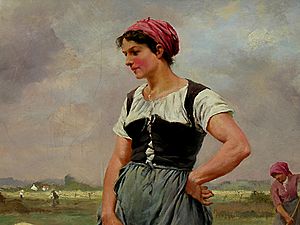Bodice facts for kids
A bodice is a type of clothing that covers the upper part of a woman's body, from the neck down to the waist. Think of it like a fitted top or a vest. Bodices have been a popular part of women's fashion for many centuries. They are often worn over a shirt or blouse and can be part of a dress or a separate garment.
Contents
What is a Bodice?
A bodice is designed to fit snugly around the torso. It usually has no sleeves, or sometimes very short ones. The main purpose of a bodice is to shape the upper body and provide support. In the past, bodices were often stiffened with materials like whalebone or stays to create a desired shape, like a narrow waist or a smooth front.
Bodices can be simple or very decorative. They might be made from different fabrics, like linen, silk, or velvet. They can also be decorated with embroidery, lace, or jewels.
Bodices Through History
Bodices have changed a lot over time, reflecting different fashion trends and ideas about how women's clothing should look.
Medieval and Renaissance Bodices
In the Middle Ages and the Renaissance (around the 14th to 17th centuries), bodices were an important part of women's dresses. They were often laced up the front or back, allowing for a snug fit. These early bodices helped create a smooth, cone-like shape for the upper body. They were sometimes worn over a chemise (a simple undergarment).
18th and 19th Century Styles
By the 18th century, bodices became more structured. They were often heavily boned to create a very specific silhouette, like a small waist and a wide skirt. These bodices were usually part of a full dress. In the 19th century, during the Victorian era, bodices continued to be very fitted. They often featured high necks, long sleeves, and intricate details. They were designed to give a modest and elegant look.
20th Century and Beyond
As fashion changed in the 20th century, bodices became less rigid. The focus shifted from extreme shaping to comfort and freedom of movement. While the term "bodice" might not be used as often today, the idea of a fitted top that forms part of a dress or is worn separately still exists. Modern bodices are usually softer and more flexible, often made from stretchy fabrics.
Why Were Bodices Worn?
Bodices were worn for several reasons:
- Fashion and Style: They helped create the fashionable silhouette of the time.
- Support: They offered support for the upper body, especially when dresses were heavy.
- Modesty: They covered the torso, which was important in many historical periods.
- Decoration: They were a canvas for showing off beautiful fabrics, embroidery, and other decorations.
Today, you might see bodices in formal wear, like wedding dresses or evening gowns. They are still used to create a flattering and elegant shape.
See also
 In Spanish: Corpiño para niños
In Spanish: Corpiño para niños



